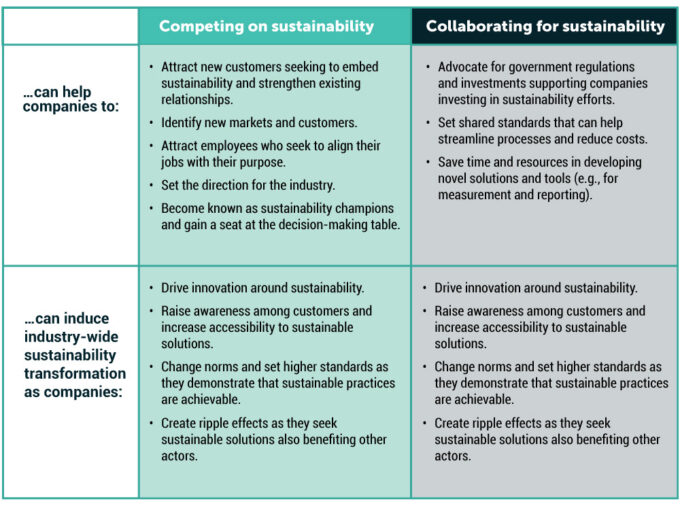
Building Better: How Baufritz is shaping the future of construction, one home at a time
Fritz-Kramer, the fourth-generation CEO of the 125-year-old family firm, is on a mission to change how Europe builds and lives more sustainably. ...

by Goutam Challagalla, Knut Haanaes Published June 5, 2025 in Sustainability • 8 min read
Competition (noun): a situation in which someone is trying to win something or be more successful than someone else.
Collaboration (noun): the situation of two or more people working together to create or achieve the same thing.
Cambridge online dictionary
“If you want to go fast, go alone. If you want to go far, go together.”- African proverb
The ‘Cola Wars’ is the term used to describe the intense rivalry between Coca-Cola and PepsiCo that emerged in the 1930s and became markedly fierce in the 1980s as they fought over customer loyalty and competed for market share. In pursuit of those goals, they conducted regular blind-taste tests, adapted their products accordingly, developed new flavors, launched extensive advertising campaigns, and worked to secure more distribution points for their drinks.
But while they were direct competitors, they also benefited from each other’s presence in the market. By creating a strong demand for cola drinks, their rivalry expanded the overall market size for soft drinks. They reached new distributors around the world, installed vending machines in the most remote places, and grew global brand and product awareness. They learned from each other’s successes and failures, adapting their strategies accordingly. In the process, they also grew the larger market, with other soft drink companies in turn benefiting from the new markets they opened.
In different industries, we can identify companies that are leading the pack and that, through their actions and communications, are competing to become known as sustainability champions.
Today, we observe a similar dynamic among businesses competing for customer loyalty through their sustainability efforts. In different industries, we can identify companies that are leading the pack and that, through their actions and communications, are competing to become known as sustainability champions. Let’s look at a few of these companies.
Schneider Electric and Siemens are positioning themselves as the technological partner of choice for companies, municipalities, and governments seeking to reduce their environmental impact. Although they do not operate in identical sectors, both companies are leaders in energy management, automation, and smart infrastructure, outpacing each other in the development of technologies and solutions for their customers. They foster an ecosystem of partners, ranging from electricians who install their products to local governments seeking to reduce their footprint. They aim to be preferred partners by setting ambitious internal sustainability targets, including reducing emissions, improving materials, reducing waste, and training employees in sustainability and energy management. Both also realize that focusing on sustainability can open doors to new markets.
In 2023, we saw two important mergers in the world of ingredients. DSM and Firmenich combined their expertise in health, nutrition, and beauty solutions to form DSM Firmenich. Meanwhile, Chr. Hansen and Novozymes merged their expertise in biosciences and biotechnology to form Novonesis, a “bio solutions partner.” Both new companies center their services and messaging around the importance and value of biologically derived solutions. In their way, they are positioning themselves as the preferred partner for companies seeking to use biological industrial solutions as alternatives to existing solutions that are harmful to the environment. Both are setting ambitious targets for internal footprint reduction; they are also pinpointing new market prospects where natural alternatives are either required (such as in agriculture), advantageous (such as in food, cosmetics, or household products), or offer a better option to conventional products (like bioplastics). Through these innovations, they are enabling their customers to reduce their environmental footprint.
The North Face, a subsidiary of VF Corporation, and Patagonia are two brands that have garnered a reputation for sustainability within the outdoor apparel sector. Patagonia is celebrated for its commitment to reducing its environmental footprint, providing lifetime repair service, and supporting grassroots movements, which help attract environmentally conscious outdoor enthusiasts. The North Face has built a similar reputation by developing products with organic or recycled materials and offering a lifetime warranty for defects. While this is not the norm in the industry, both brands have developed second-hand platforms—Patagonia Worn Wear and The North Face Renewed—where customers can buy second-hand or remanufactured products. Both also give back to the community: a significant part of Patagonia’s profits is funneled into environmental causes. For its part, The North Face has set up the Explore Fund, which promotes outdoor exploration. Through their products, initiatives, and communication, both companies market themselves as true allies to those who enjoy outdoor exploration while respecting their environment.

“Making money on sustainability is the defining trait of these rivalries, as they integrate sustainability into their core business strategies.”
Although these companies may not continuously look over their shoulders to see what their rivals are doing, each strives to be a sustainability champion within their industry. There is value here; either sustainability pays off in the short term or it is an investment in medium- to long-term success. As such, intense competition, or “Cola Wars,” leads these companies to push for sustainability competitiveness. Here are four lessons from these four examples for managers:
“Cola Wars” rivalries prompt companies to focus exclusively on material aspects of sustainability, as these issues directly impact their business performance, shareholder expectations, and long-term resilience. Sustainability becomes strategy. By prioritizing material areas, they naturally address challenges central to their operations and brand reputation. By concentrating on material issues, these companies focus on what mitigates risks and creates value through innovation, efficiency, and more robust consumer loyalty, ensuring their sustainability efforts drive meaningful and measurable business outcomes.
Making money on sustainability is the defining trait of these rivalries, as they integrate sustainability into their core business strategies. These companies leverage environmental and social practices to unlock profitable business opportunities, investing heavily in scalable products and solutions that deliver financial and environmental returns. For instance, both Siemens and Schneider Electric drive efficiencies in sustainable solutions to reduce costs. These companies also demonstrate that aligning profitability with sustainability triggers innovation, accelerates the time-to-market for new offerings, and builds customer trust, proving that sustainable practices can drive business growth and have a long-term global impact.
By exceeding the standards within their respective industries, these companies are positioning themselves as the preferred choice for customers seeking to minimize their environmental footprint. The focus on sustainability also helps identify new customers and market opportunities. As the Cola Wars led to the development of new products (diet, caffeine-free, etc.,) the push to be known as a sustainability champion can stimulate companies to innovate more creatively. The companies described above are all developing new ingredients, materials, technologies, products, and services to help them enter new markets.
Inspiration beats fear. These companies show that employees may face climate anxiety but will commit and act only once inspired. As sustainability champions, these companies are also better positioned to attract employees who seek to align their jobs with their purpose, fostering a passionate workforce committed to the company’s mission. These companies show that there are alternatives to business as usual and set the direction for industry development. Their leadership enhances their reputation and positions them as preferred partners for other organizations and stakeholders committed to sustainability.
Taken together, these companies raise the bar. As they battle to gain a prime position in their customers’ minds, they are also creating ripple effects within their respective industries, whether they mean to or not. They are investing in developing new products and solutions that others can adopt or seek to emulate. They are raising awareness among customers and increasing accessibility to sustainable solutions. By demonstrating that sustainable practices are achievable, they change norms and set higher standards. Additionally, as they seek sustainable solutions from suppliers and partners, they induce sustainability transformations throughout their supply chains.

While striving to be sustainability champions within their sector, the companies mentioned above also collaborate with their competitors to achieve sustainability goals. We examined the websites and annual reports of each pair of companies and other sustainability champions to identify the industry associations and cross-industry networks with which they engage. We found that companies collaborate with these organizations on several fronts.
Collaboration, however, requires transparency about the objectives you are trying to reach, a willingness to share knowledge, and an openness to discussing challenges and setting shared goals – the opposite of competition. Executives are also taught to be wary of collaboration due to antitrust laws. In some situations, however, such as environmental protection, collaboration can be both legal and valuable.
Companies can collaborate to advocate for changes in government policy and structural investments. For example, Schneider Electric and Siemens are both members of the European Alliance to Save Energy, which advocates for policies and financing mechanisms that promote energy efficiency. This can help accelerate the adoption of energy efficiency solutions, enabling the achievement of climate goals while helping companies better support their customers.
Through industry organizations, companies also work together to develop shared industry standards. For example, the Federation of European Specialty Food Ingredients Industries, whose members include Novonesis and DSM Firmenich, aims to set standards for the food ingredients industry. Harmonized standards within an industry, such as how companies communicate about ingredients, can help provide transparency, streamline processes, and reduce costs for all companies within the industry.
Companies also collaborate to co-develop tools for measuring, tracking, and reporting emissions. Cascale is an organization that supports apparel companies, such as Patagonia and The North Face, in measuring and reporting their environmental footprints. Rather than each company developing its own tools, collaborative efforts can help save time and resources.
Finally, we see companies joining initiatives that enable them to exchange and innovate together. Through the Outdoor Industry Association, for example, companies like Patagonia and The North Face collaborate to exchange knowledge and phase out harmful chemicals from outdoor products. Through the Ellen McArthur Foundation, even rivals like Coca-Cola and PepsiCo, who aren’t specifically sustainability leaders, can collaboratively learn and accelerate efforts to develop products and systems that fit in a Circular Economy. By working together, the companies can help define the playing field for all companies in the industry.
Some might mention the potential pitfalls of collaboration. Indeed, cooperation among the largest companies can lead to situations where smaller companies struggle to compete. It could also lead to new regulations and standards that benefit the companies that have advocated for them, but harm smaller companies or companies in other geographies. To be effective in the long run, companies must ensure that a wide range of voices are heard and included.
The vast number of industry associations worldwide, coupled with the tendency of companies to join multiple organizations, underscores the value companies place on collaboration. Sustainability brings companies together, whether they are strongly driven by sustainability goals or longtime rivals such as Coca-Cola and PepsiCo. Through collaboration, companies can elevate the standards and regulations, making it desirable for all to adopt tools and strategies that protect our environment.

The authors would like to thank Bryony Jansen van Tuyll for her contributions to this article.

Professor of Marketing and Strategy and dentsu Group Chair in Sustainable Strategy and Marketing at IMD
Goutam Challagalla is Professor of Strategy and Marketing and dentsu Group Chair in Sustainable Strategy and Marketing at IMD. His teaching, consulting, and research focuses on strategy with a focus on digital transformation, business-to-business commercial management, value-based pricing, sales management, distribution channels, and customer and service excellence. At IMD, he is Director of the Advanced Management Program (AMP), Integrating Sustainability into Strategy, and Strategy Governance for Boards.

Lundin Chair Professor of Sustainability at IMD
Knut Haanaes is a former Dean of the Global Leadership Institute at the World Economic Forum. He was previously a Senior Partner at the Boston Consulting Group and founded their first sustainability practice. At IMD he teaches in many of the key programs, including the MBA, and is Co-Director of the Leading Sustainable Business Transformation program (LSBT) and the Driving Sustainability from the Boardroom (DSB) program. His research interests are related to strategy, digital transformation, and sustainability.

December 12, 2025 • by Julia Binder, Manuel Braun in Industrials
Fritz-Kramer, the fourth-generation CEO of the 125-year-old family firm, is on a mission to change how Europe builds and lives more sustainably. ...

November 18, 2025 • by Miljan Gutovic in Industrials
Growing demand for building materials requires novel approaches to construction. Holcim CEO Miljan Gutovic shows how his company has adopted circularity as a new way to grow the business....

November 13, 2025 • by Simon J. Evenett, Fernando Martín Espejo in Industrials
Industrial policy is reshaping global competitiveness, strategy, and innovation as governments pursue resilience, security, and growth....

September 16, 2025 • by Jean-François Manzoni in Industrials
Morten Wierod, President and CEO of ABB tells Jean-François Manzoni how a leaner-and-cleaner mission, decentralized discipline, and a culture of speed are driving its transformation for the road ahead....
Explore first person business intelligence from top minds curated for a global executive audience